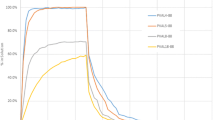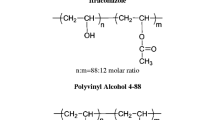Abstract
The aim of this study was to investigate the influence of the production method and the polymeric carrier on the ability to generate and maintain the supersaturation of a poorly soluble drug in biorelevant medium. The amorphous solid dispersion of sulfamethoxazole, an antibacterial drug, was produced using two different polymers by spray-drying or hot melt extrusion methods. When Eudragit EPO was used, supersaturation was maintained up to 24 h for both techniques at all drug-polymer proportions. However, when Soluplus was employed in hot melt extrusion, a smaller amount of drug was dissolved when compared to the amorphous drug. The proportion of 3:7 drug-Eudragit EPO (w/w) produced by spray-drying presented a higher amount of drug dissolved in supersaturation studies and it was able to maintain the physical stability under different storage conditions throughout the 90-day evaluation. Supersaturation generation and system stability were found to be related to more effective chemical interaction between the polymer and the drug provided by the production method, as revealed by the 1D ROESY NMR experiment. Investigation of drug-polymer interaction is critical in supersaturating drug delivery systems to avoid crystallization of the drug and to predict the effectiveness of the system. Chemical compounds studied in this article: Sulfamethoxazole (PubChem CID: 4539) and Methacrylate copolymer — Eudragit EPO (PubChem CID: 65358)







Similar content being viewed by others
Abbreviations
- API:
-
Active pharmaceutical ingredients
- ASD:
-
Amorphous solid dispersion
- BCS:
-
Biopharmaceutical Classification System
- FaSSIF:
-
Fasted State Simulated Intestinal Fluid
- SDDS:
-
Supersaturating drug delivery systems
- SLM:
-
Sulfamethoxazole
- Soluplus:
-
Polyvinyl caprolactam–polyvinyl acetate–polyethylene glycol graft copolymer
References
Brouwers J, Brewster ME, Augustijns P. Supersaturating drug delivery systems: the answer to solubility-limited oral bioavailability? J Pharm Sci. 2009;98(8):2549–72.
Raina SA, Zhang GGZ, Alonzo DE, Wu J, Zhu D, Catron ND, et al. Enhancements and limits in drug membrane transport using supersaturated solutions of poorly water soluble drugs. J Pharm Sci. 2014;103(9):2736–48.
Taylor LS, Zhang GGZ. Physical chemistry of supersaturated solutions and implications for oral absorption. Adv Drug Deliv Rev. 2016;101:122–42.
Gilley AD, Arca HC, Nichols BLB, Mosquera-Giraldo LI, Taylor LS, Edgar KJ, et al. Novel cellulose-based amorphous solid dispersions enhance quercetin solution concentrations in vitro. Carbohydr Polym. 2017;157:86–93.
Zhou D, He S, Cong Y, **e Z, Chen X, **g X, et al. A polymer-(multifunctional single-drug) conjugate for combination therapy. J Mater Chem B. 2015;3(24):4913–21.
Santos A, Sinn Aw M, Bariana M, Kumeria T, Wang Y, Losic D. Drug-releasing implants: current progress, challenges and perspectives. J Mater Chem B. 2014;2:6157–82.
Adebisi AO, Kaialy W, Hussain T, Al-Hamidi H, Nokhodchi A, Conway BR, et al. Solid-state, triboelectrostatic and dissolution characteristics of spray-dried piroxicam-glucosamine solid dispersions. Colloids Surfaces B Biointerfaces [Internet]. 2016 Oct 1 [cited 2018 Sep 3];146:841–51. Available from: https://www.sciencedirect.com/science/article/pii/S0927776516305343
Harmon P, Galipeau K, Xu W, Brown C, Wuelfing WP. Mechanism of dissolution-induced nanoparticle formation from a Copovidone-based amorphous solid dispersion. Mol Pharm. 2016;13(5):1467–81.
Genina N, Hadi B, Löbmann K. Hot melt extrusion as solvent-free technique for a continuous manufacturing of drug-loaded mesoporous silica. J Pharm Sci. 2018;107(1):149–55.
Paudel A, Worku ZA, Meeus J, Guns S, Van Den Mooter G. Manufacturing of solid dispersions of poorly water soluble drugs by spray drying: formulation and process considerations. Int J Pharm. 2013;453(1):253–84.
Lindenberg M, Kopp S, Dressman JB. Classification of orally administered drugs on the World Health Organization model list of essential medicines according to the biopharmaceutics classification system. Eur J Pharm Biopharm. 2004;58(2):265–78.
Eliopoulos GM, Huovinen P. Resistance to trimethoprim-sulfamethoxazole. Clin Infect Dis. 2001;32(11):1608–14.
Alonzo DE, Zhang GGZ, Zhou D, Gao Y, Taylor LS. Understanding the behavior of amorphous pharmaceutical systems during dissolution. Pharm Res. 2010;27(4):608–18.
PA Masters, TA O'Bryan, J Zurlo, DQ Miller, N Joshi Trimethoprim-sulfamethoxazole revisited. Arch Intern Med 2003;163(4):402–410. Available from: https://doi.org/10.1001/archinte.163.4.402
Tian Y, Jones DS, Andrews GP. An investigation into the role of polymeric carriers on crystal growth within amorphous solid dispersion systems. Mol Pharm. 2015;12(4):1180–92.
Caron V, Hu Y, Tajber L, Erxleben A, Corrigan OI, McArdle P, et al. Amorphous solid dispersions of sulfonamide/soluplus® and sulfonamide/PVP prepared by ball milling. AAPS PharmSciTech. 2013;14(1):464–74.
Pharmacopieial Convention U. S. USP [Internet]. Estándares de Referencia 2008. Available from: http://www.usp.org/es/estandares-de-referencia/hojas-de-datos-tecnicos
ICH guidelines. Q2(R1): Validation of analytical procedures: text and methodology. Int Conf Harmon. 2005;1994(November 1996):17.
Niu J, Zhang L, Li Y, Zhao J, Lv S, **ao K. Effects of environmental factors on sulfamethoxazole photodegradation under simulated sunlight irradiation: kinetics and mechanism. J Environ Sci (China). 2013;25(6):1098–106.
Wang P, Zhang D, Zhang H, Li H, Ghosh S, Pan B. Impact of concentration and species of sulfamethoxazole and ofloxacin on their adsorption kinetics on sediments. Chemosphere. 2017;175:123–9.
Hardung H, Djuric D, Ali S. Combining HME & solubilization: Soluplus® - the solid solution. Drug Deliv Technol. 2010;10(3):20–7.
Khachane P, Date AA, Nagarsenker MS. Eudragit EPO nanoparticles: application in improving therapeutic efficacy and reducing ulcerogenicity of meloxicam on oral administration. J Biomed Nanotechnol. 2011;7(4):590–7.
Barbosa JAC, Abdelsadig MSE, Conway BR, Merchant HA. Using zeta potential to study the ionisation behaviour of polymers employed in modified-release dosage forms and estimating their pKa. Int J Pharm X. 2019;1:100024. Available from: https://doi.org/10.1016/j.ijpx.2019.100024.
**e T, Gao W, Taylor LS. Impact of Eudragit EPO and hydroxypropyl methylcellulose on drug release rate, supersaturation, precipitation outcome and redissolution rate of indomethacin amorphous solid dispersions. Int J Pharm. 2017;531:313–23.
Thiry J, Broze G, Pestieau A, Tatton AS, Baumans F, Damblon C, et al. Investigation of a suitable in vitro dissolution test for itraconazole-based solid dispersions. Eur J Pharm Sci. 2016;85:94–105.
**a D, Yu H, Tao J, Zeng J, Zhu Q, Zhu C, et al. Supersaturated polymeric micelles for oral cyclosporine A delivery: the role of Soluplus–sodium dodecyl sulfate complex. Colloids Surfaces B Biointerfaces [Internet]. 2016 May 1 [cited 2018 Sep 3];141:301–10. Available from: https://www.sciencedirect.com/science/article/pii/S0927776516300479
Hughey JR, Keen JM, Miller DA, Kolter K, Langley N, McGinity JW. The use of inorganic salts to improve the dissolution characteristics of tablets containing Soluplus??-based solid dispersions. Eur J Pharm Sci 2013;48(4–5):758–766. Available from: https://doi.org/10.1016/j.ejps.2013.01.004
Acknowledgments
The authors would like to thank Dr. Adailton J. Bortoluzzi for technical support during XRPD analyses, Laboratório Central de Microscopia Eletrônica (LCME) for SEM measurements and Post-graduation Program in Chemistry of Universidade Federal de Santa Catarina for the facilities.
Funding
This study was supported by the Coordination for Enhancement of Higher Education Personnel (CAPES) — financial code 001.
Author information
Authors and Affiliations
Corresponding author
Ethics declarations
Conflict of Interest
The authors declare that they have no conflicts of interest.
Additional information
Publisher’s Note
Springer Nature remains neutral with regard to jurisdictional claims in published maps and institutional affiliations.
Electronic Supplementary Material
ESM 1
(DOCX 2099 kb)
Rights and permissions
About this article
Cite this article
Mendes, C., Andrzejewski, R.G., Pinto, J.M.O. et al. Impact of Drug-Polymer Interaction in Amorphous Solid Dispersion Aiming for the Supersaturation of Poorly Soluble Drug in Biorelevant Medium. AAPS PharmSciTech 21, 189 (2020). https://doi.org/10.1208/s12249-020-01737-6
Received:
Accepted:
Published:
DOI: https://doi.org/10.1208/s12249-020-01737-6




